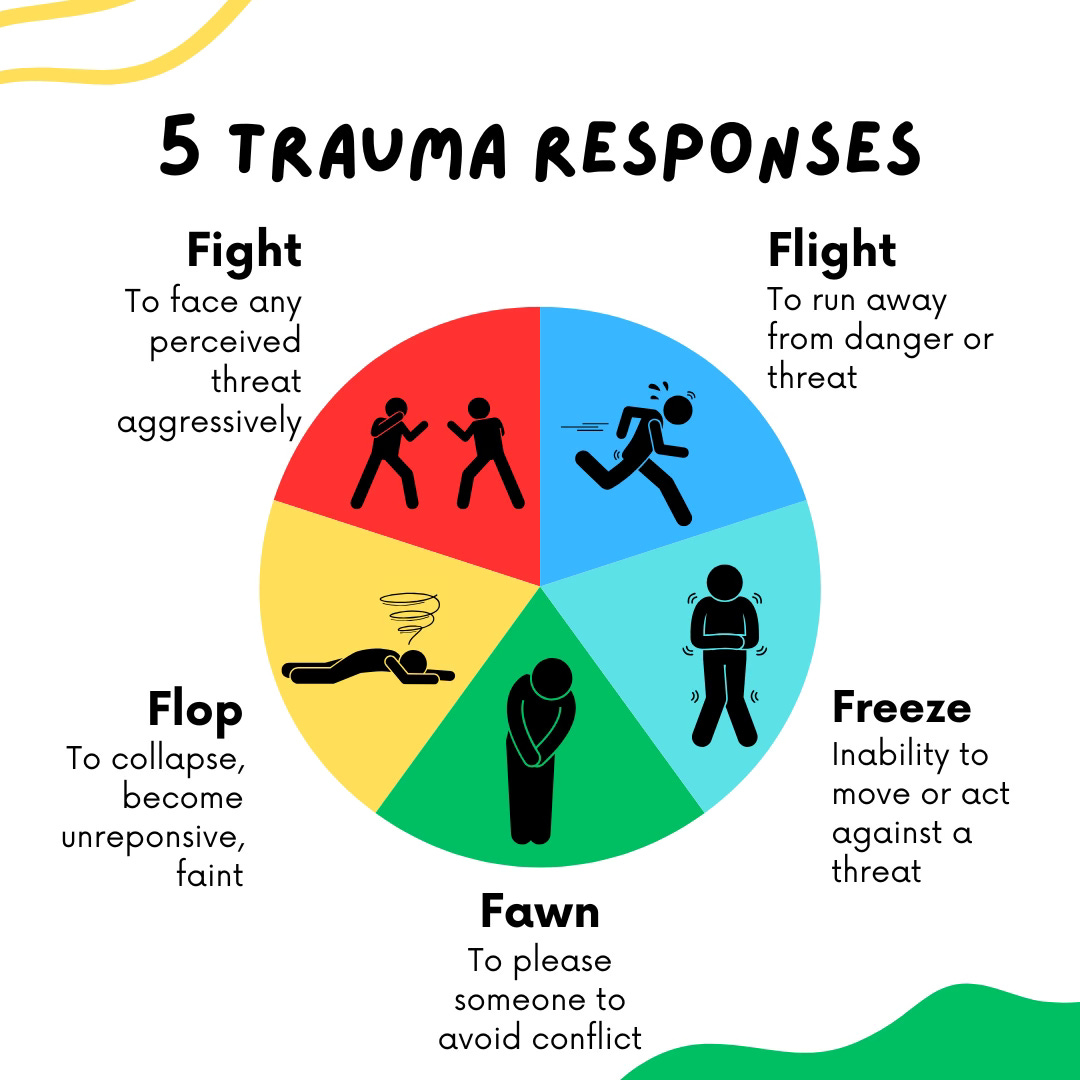How Your Nervous System Perceives Emotional Threat
And How Narcissistic/Dysfunctional Families Trigger This Threat
This week an Instagram post popped up in my feed from a woman named Janelle Marie. She is an engineer who posts exclusively on mother-in-law/daughter-in-law relationships. In this post she says, “Unfortunately my body can’t tell the difference between seeing a text come in from my MIL and being chased by a bear.” It made me laugh out loud, and it is also very true. Our bodies cannot tell the difference.
But why would our bodies respond to people who feel “unsafe” with fight, flight, freeze, fawn or flop, all of which have all been labeled as trauma responses? Well, it comes down to our wonderful, beautiful nervous system. If you didn't read my article on “Reclaiming Playfulness After Trauma”, here is a quick recap of how our nervous system works. When the body perceives danger, its survival responses of fight, flight, freeze, fawn get activated. The stress hormones cortisol and adrenaline flood our system, readying us to defend ourselves, flee to safety, freeze, or appease the aggressor (fawn). Our heart rate speeds up, muscles tense, the breath becomes shallow. We can often feel a lot of energy in our body and alertness. In extreme cases we may collapse or “play dead” (flop). After the danger passes, a healthy nervous system is able to release this survival energy and return to a relaxed state. We see animals do this in the wild when they shake or run after an attack.
We understand this response in our bodies when we are faced with overt aggression or physical or sexual violence. But a mother-in-law? Stick with me.
One of the primary ways we evolved to stay safe was by staying close, meaning physically and emotionally connected to other humans. Our feelings help us do that. They are data, providing us with real time information on when relationships are going well or are amiss. Learning to listen to and understand our emotions helps us make choices that protect our emotional wellbeing. When we feel emotionally safe with other people, we are are essentially saying that we feel ok being ourselves, being authentic and vulnerable without fear of judgment, criticism, ridicule or negative consequences. When people feel safe, their bodies shift into the parasympathetic (aka rest-and-digest) state. This physiological state is actually shared between people who feel comfortable with one another, and it promotes bonding and attachment. This synchronization is thought to increase feelings of empathy and connection and help regulate the stress response.
Conversely, feeling emotionally unsafe means feeling that any expression of your true, authentic self will be attacked, belittled, undermined or simply ignored by people who are supposed to love and protect you, or who matter to you. It is difficult, if not impossible to shift into the parasympathetic state in the face of feeling threatened with fear of rejection or exclusion from important relationships, or a fear that who you are is fundamentally unacceptable to people. The absence of emotional safety in relationships can lead to anxiety, withdrawal, difficulty forming close relationships, and reluctance to take reasonable risks or try new things.
Your nervous system does not know the difference between a bear chasing you and a person who has repeatedly manipulated you, tried to control you, bullied you and engaged in other forms of relational aggression. One of your nervous system’s primary jobs is to keep you safe. So it assesses for danger and proceeds accordingly. And that danger can be anything from an overbearing, cruel MIL to a very hungry bear. This is because the nervous system responds to lack of emotional safety the same way it responds to lack of physical safety: You get the urge to run or hide. Your muscles tense and your jaw clenches and anger comes bubbling to the surface. You freeze, like a deer caught in headlights and your breath gets shallow. This is not a mistake or poor design. Staying close and connected to others is part of how we survived as a species.
It is close to impossible to foster healthy attachment and bonding when you are constantly in a state of fight or flight or emotionally dysregulated. Even more interesting, there is research that points to a correlation between people who have high traits of narcissism being in a constant state of physiological arousal, aka fight-or-flight, aka dysregulated. 1 This makes co-regulation, the parasympathetic state we talked about earlier where two people soothe one another and connect, next to impossible. Imagine having that for a parent. Indeed, anyone who has spent time around a full blown narcissist will attest to their ability to sow chaos. This is their own dysregulation getting externalized onto others. Creating instability gives them a sense of control and mirrors their own internal hot mess. By creating environments of constant uncertainty through emotional manipulation, boundary violations and fabricating crises, narcissists inflict a high level of emotional instability and a profound lack of emotional safety onto the people around them.
Emotionally immature and dysfunctional families often struggle with emotional safety as well, because the individuals who make up these families lack the skills to regulate their own emotions, which makes it difficult for them to attune to others. They are in sympathetic arousal more frequently (fight/flight) and often miss social cues that facilitate co-regulation. However unlike narcissists, they have the capacity to learn, if they so choose.
In relationships or environments where people feel chronically emotionally unsafe, chronic nervous system dysregulation can also develop, leading to complex trauma over time. This perpetual state of dysregulation not only impacts individual mental and physical health but can be passed down generationally through disrupted attachment patterns and altered stress responses, creating cycles of trauma that affect entire communities and societies.
So, yes, if your lived experience with your MIL, or any of your in-laws, is that you are not allowed to be authentically you, or that showing up as you are results in rejection, hostility, or aggression, then there is a good chance that over time communication with them will trigger your fight/flight/fawn/freeze/flop response. This is your nervous system hard at work, keeping you safe and alerting you to threats. Yay, and also, this is not an ideal long term solution for your body. It keeps you under high levels of stress.
The solution? Creating rituals for nervous system support, having boundaries in place (including going no contact if warranted), finding a supportive community and regularly self reflecting on your experiences then validating them when appropriate.
Nervous System Support:
Regular grounding practices like deep breathing, movement, or nature connection
Creating "safety anchors" - physical objects or spaces that help you feel secure
Practicing self-regulation techniques before and after interactions
Using sensory tools like weighted blankets or calming music
Building in recovery time after difficult interactions
Boundary Maintenance:
Limiting exposure when possible
Creating emotional distance while maintaining necessary contact
Setting clear internal boundaries about what you will/won't engage with
Developing scripts for difficult interactions
Having an exit strategy for overwhelming situations
Building External Support:
Maintaining connections with emotionally safe people
Regular contact with a therapist or counselor
Joining support groups for similar situations
Creating a strong support network separate from the unsafe person
Self Reflection Practices:
Regular self-validation to counter gaslighting or manipulation
Maintaining a clear sense of reality through journaling or documentation
Practicing self-compassion when triggered
Recognizing that their behavior reflects their issues, not your worth
What do you think of emotional safety? Have you ever felt like it was not safe to be who you are? How have you coped with a lack of emotional safety in family, friends or broader society?
Ronningstam, E. Intersect between self-esteem and emotion regulation in narcissistic personality disorder - implications for alliance building and treatment. bord personal disord emot dysregul 4, 3 (2017). https://doi.org/10.1186/s40479-017-0054-8







This should be taught in kindergarten instead of by the seat of our pants.
For as long as I can remember, I instinctively practiced forms of fawning or hiding in a hope chest, closet, under a bed or behind the curtains when faced with fierce trauma ala generational familial scapegoating (bio & by-law).
Thank you for applying a clear voice to an important human condition that has been wandering alone in the desert for way too long.
Fantastic article, Claire, and much needed. Just restacked it!